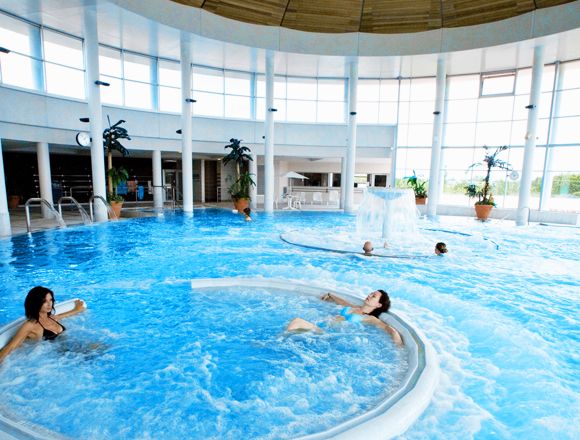Taylor Balance
The Taylor Balance is used to determine the calco-carbonic balance for optimal water quality in swimming pools. If this balance is not found and maintained, it can lead to:
-
-
-
-
-
- a very fluctuating pH,
- whitish deposits on the walls,
- cloudy water.
-
-
-
-
What is the calco-carbonic balance?
Definition
The water balance in a swimming pool is delicate to maintain. To do so, it is necessary to determine the right calco-carbonic balance.
The Taylor’s Balance is a tool to know what is the balance to be reached between :
- The TAC: Complete Alkalimetric Title corresponding to the quantity of carbonates and bicarbonates in the water. It is expressed in °F or in ppm (1°F = 10 ppm). It characterizes the buffering capacity of the water. The TAC must be between 10 and 30°F,
- The TH: Hydrotimetric Title corresponds to the quantity of calcium and magnesium (limestone) in the water. It is expressed in °F or in ppm (1°F = 10 ppm). The TH characterizes the hardness of the water. The TH must be between 10 and 20°F,
- The pH value: The pH is the hydrogen potential of water. It measures the acidity of the water from 0 to 14.
– Acidic if the pH is less than 7
– Neutral if the pH is equal to 7
– Basic if the pH is higher than 7
The pH remains the easiest element to correct. The biggest difficulty will be to stay within the efficiency range of the disinfectant used.
Control periodicity:
- When the pools are put in water,
- then once a quarter.

How to use the Taylor balance?
Determine the calco-carbon equilibrium
To determine the calco-carbonic balance of water using the Taylor Balance, the method to follow is:
- Measure the TH and TAC with a portable photometer,
- Then, point the results on the Taylor scale on the left and right scales,
- After that, draw a line between the two results,
- Finally, the graph indicates the ideal pH to try to reach on the pool in order to be in calco-carbonic balance.
The objective is to comply with regulations with a pH between 6.9 and 7.7 and generally between 7.2 and 7.4.
However, it is sometimes easier to act on other parameters such as TH and TAC.
Indeed, if, for example, the TAC is 15°F and the Th is 9°, this gives an ideal pH according to Taylor’s Balance at 7.8. However, if the pH target is 7.2, it will be necessary to act on the TAC rather than on the pH in order to lower it. This will also avoid using too much acid to achieve the desired pH objective.
What is the right pH in a public pool?

How to measure the pH of the water?
The pH of the water is measured with a photometer for self-monitoring and with a continuous analysis device for on-line measurement and control.
Comment mesurer le pH de l'eau ?
En piscines publiques et collectives, la réglementation indique que le pH doit être idéalement proche de 7,2 et 7,4 de pH.
En effet, il conditionne l’efficacité du désinfectant et l’équilibre calco-carbonique essentiel pour le traitement de l’eau.
What is the TAC (Total Alkalinity Content)?
Definition
The TAC is not indicated in the regulations for public pools but it is recommended to check it at least once a year. It corresponds to the quantity of carbonates and bicarbonates in the water. It is expressed in °F or in ppm (1°F = 10 ppm) and characterizes the buffering capacity of the water.
- Water with a low TAC, i.e. less than 10°F, causes strong variations in pH
- Water with a high TAC, i.e. above 30°F, causes whitish deposits on the water line and difficulties in correcting the pH. In this case, the water is said to be buffered.
How to change the TAC?
To modify the TAC :
- it is necessary to inject, among other things, sodium bicarbonate to increase it
- to reduce it, it is necessary to inject acid.
This is why it is advisable to maintain it between 10°F and 30°F to have a sufficient buffer power, guaranteeing a good stability of the water.
How to measure the TAC of water?
The TAC of the water is measured with a photometer.

What is the TH (Hydrotimetric Title)?
Definition
Like the TAC, it is recommended to monitor the TH at least once a year.
The latter corresponds to the quantity of calcium and magnesium (limestone) in the water. It is expressed in °F or in ppm (1°F = 10 ppm) and characterizes the hardness of the water.
There are no regulations for public pools but it is recommended to maintain the TH between 10°F and 20°F to avoid problems of corrosion or scaling:
- Water with a low TH, i.e. less than 10°F, is very soft and tends to corrode metals
- Water with a high TH, i.e. above 20°F, is hard water that causes scale to form on the walls
How to measure the TH of water?
The TH of the water is measured with a photometer.

We are here to support you …
Do you have any questions? Need a diagnosis, recommendations? Need a documentation, an estimate ? The SYCLOPE team is at your disposal …


